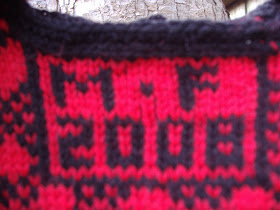
Halland sweaters became stranded in the 19th century as documented in the fantastic "Swedish Sweaters, New Designs from Historical Examples" by Britt-Marie Christoffersson. I used this book as well as Knitting in the Old Way, Designs & Techniques from Ethnic Sweaters", Roberts & Robson to experiment with all of the area's signature techniques.

My sweater is primarily in the Ullared style. I used traditional diamond patterns with a typically placed record of the year and my initials. These sweaters bore the wearers rather than the makers initials, in this case they are one in the same. I also followed the oldest tradition of finishing using crochet to work the neck and cuff edges.

Using assorted geometric patterns from "Swedish Sweaters" I inserted 'false seam lines' using colour to line up the circular knitting with the point at which the front and back began to be worked flat. I also made half gussets following Plan 1 for the Danish Blouse in Knitting in the Old Way and patterned them separately.

The main adjustments I made were to change the shape of the sweater to the Danish cropped style, or the Swedish Spedetroja look. I also started with a split welt hem. I don't suit a big boxy sweater.
Using worsted weight wool is a major modernization along with the use of red yarn. Traditionally, these (and most Swedish) sweaters would have been knit in black and white and then dyed red.

You see, I had to post this before it was too late!

I love this sweater. Good Job
ReplyDelete